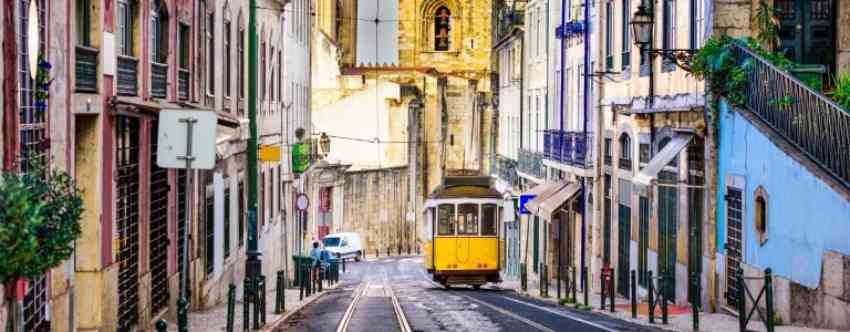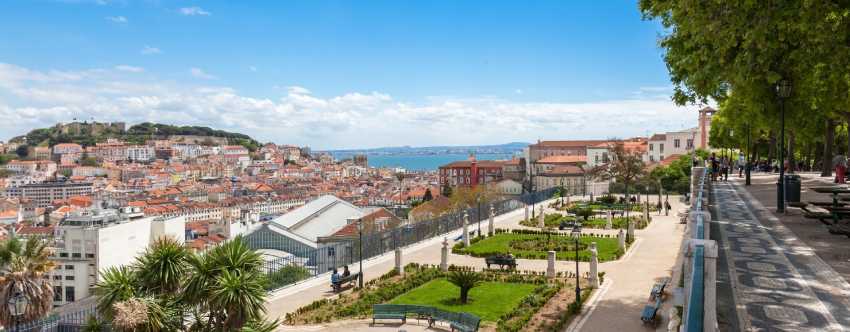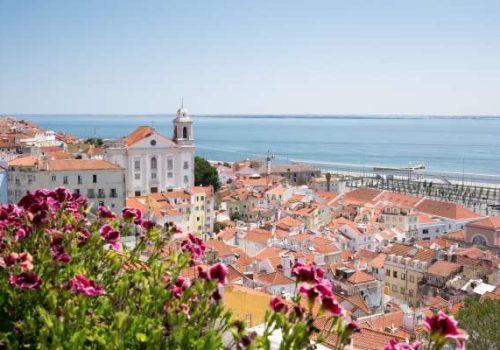Live and work in Lisbon
Lisbon is also known as ‘the white city’. Sounds very romantic doesn’t it? Portugal’s capital is built on seven hills and has plenty of winding and picturesque streets. There are also many beautiful fountains, squares and shopping malls.
Once you start living and working in Lisbon, you’re going to enjoy yourself quite a bit outside of work! Enjoy the vibrant city, the friendly people and, of course, the great weather. The city has many beautiful places and sights and there is more than enough to see and discover.
Lisbon is not only the capital of Portugal, but also its largest city. The city has almost 550,000 inhabitants. Are you curious? I’m sure you have! Read on to find out what it’s like to live and work in Lisbon.
Latest jobs in Lisbon and Portugal
- Customer support
- Portugal
- Customer support
- Portugal
- Customer support, Marketing
- Portugal
- Customer support
- Portugal
Working in Lisbon
Working conditions in Lisbon
In Portugal, it is illegal to work more than 40 hours a week and more than 8 hours a day. Most companies offer contracts of 35 to 40 hours spread over a 5-day working week. Also bear in mind that many Portuguese companies are also open on Saturdays, so you may be asked to come to work on weekends.
Salaries in Lisbon
The average net monthly salary in Lisbon is around €1,141. The cost of living in Lisbon is lower than in the Netherlands and Belgium and this salary will allow you to live a good life in Lisbon.
Holidays: every worker is entitled to a minimum of 22 paid holidays per year. This does not include the country’s 13 public holidays.
Taxation in Lisbon
If you are going to work and live in Lisbon, you will also have to pay tax on your income. Portugal has a progressive income tax system. This means that the more you earn, the higher your tax rate will be. In total, there are 4 tax brackets in Portugal and the rates range from 14% to 48%. The highest marginal tax rate of 48% applies to incomes above €80,000 per year.
In addition, there are various exemptions and deductions that you can qualify for and thus pay less tax.
Work culture in Lisbon
Lisbon is known for its relaxed Mediterranean lifestyle and this lifestyle is also reflected in the workplace. There is a relaxed and pleasant working atmosphere and a good work-life balance at most companies. Portuguese work hard and are ambitious, but they also know better than anyone how to enjoy their free time.
Moreover, Portuguese are quite relationship-oriented, which is why they generally put a lot of time and effort into building relationships with their colleagues. Furthermore, punctuality is not that important in Portugal. Thus, long lunch breaks are common and you should not be surprised if your meeting starts 30 minutes later.
Networking in Lisbon
If you are looking for a (new) job in Lisbon, networking is a good way to find one. There are plenty of coworking spaces in Lisbon where you can meet professionals and potential employers. There are also many networking events organised in Lisbon. For example, consider Web Summit, one of the biggest tech conferences in the world. Visit the event, connect with startups, potential employers and learn all about the latest innovations.
For a complete list of all networking events in Lisbon, take a look at https://www.eventbrite.com/.
Working in Lisbon experiences
Do you love the challenge of living and working in Lisbon? And are you curious to know what it is like to work for one of our clients in Portugal? Then we recommend you read this blog about our candidate’s living and working experience in Portugal.
Living in Lisbon
Benefits of living and working in Lisbon
Lisbon is becoming increasingly popular among expats and tourists. And that is not surprising!
After all, the city is full of modern shopping centres and the residential areas are beautiful!
So there are plenty of reasons to live and work in Lisbon. Often, though, the main reason is the climate. In summer, temperatures can reach above 35 degrees. In addition, the friendly atmosphere and beautiful nature also make for an attractive and pleasant living environment.
More and more people are taking the step to live and work in Lisbon. Thanks to this international character, Lisbon is also becoming increasingly multicultural. In addition, life in Lisbon is also considered very pleasant by the locals. There is almost always something to see on the streets.
Accommodation in Lisbon
You can rent a flat in Lisbon from €770 a month. Want to live in the centre of Lisbon?
Then you’ll often spend a few hundred euros more. There are also properties that are cheaper, but it takes some searching. You could also consider sharing a flat with a friend.
We also recommend building a network in Lisbon to help you find a suitable and affordable property more quickly and easily.
The websites below may come in handy in your search for accommodation in Lisbon:
Transport in Lisbon
Lisbon is great to explore on foot.
Although the city is full of small and steep streets, making it a bit difficult to get around at times. But luckily you can always use public transport if you don’t feel like walking.
Even Lisbon’s trams are a real sight to behold. For instance, tram 12 and tram 28 have a nostalgic character, making them very popular among tourists. There are different types of tickets you can buy for public transport.
A distinction is made between Metro Lisboa (metro), Carris (bus and tram), Comboios Urbanos de Portugal (CP local trains) and Transtejo e Soflusa (ferries). There are only five routes across the Tagus River operated by Transtejo e Soflusa. These are: Terreiro do Paço – Barreiro, Cais do Sodré – Montijo, Cais do Sodré – Seixal, Cais do Sodré – Cacilhas and Belém – Porto Brandão – Trafaria.
Single tickets and day passes in Lisbon
Single tickets can be bought on board a bus or tram.
A bus ticket costs around €1.85 and a tram ticket costs around €3. A metro ticket can be bought at the station and costs around €1.45. If you want to explore the centre of Lisbon by public transport, the best way to go is by tram. The four modes of transport (metro, bus, tram and lift) are cheaper if you use ‘zapping’, as the price of a ticket is €1.30 each way.
It is also possible to buy day passes. A day ticket for metro, bus and tram costs €6.15. This card is valid for 24 hours. The price of a day ticket is €9.15 if you also use the Transtejo e Soflusa ferry between Cais do Sodré and Cacilhas. A day pass for Lisbon’s metro, bus, tram and CP local trains costs €10.15.
Rechargeable Viva Viagem or 7 Colinas card
While day passes are very convenient to use, it is cheaper to purchase a Viva Viagem or 7 Colinas .
This is a kind of public transport chip card. It does not matter which card you purchase, as both tickets work in the same way. The cards can be bought for €0.50 each. A balance can then be set up. With this balance, you travel cheaper than if you buy separate tickets each time.
A single trip, by zapping (checking in and out), costs €1.30 for metro, bus and tram. You buy a rechargeable Viva Viagem or 7 Colinas card at Lisbon Airport at Metro Lisboa and Carris (owner of bus and tram) outlets. These outlets can be found all over the city and at stations. With a Viva Viagem or 7 Colinas card, popular attractions such as tram 12, tram 28 and the Santa Justa Lift cost very little.

Eating in Lisbon
Lisbon is a great place to eat!
From traditional Portuguese restaurants in the popular Alfama district to trendy restaurant formulas in Bairro Alto. The culinary delights will soon be yours, no matter where you sit down. There are also plenty of wine bars in Lisbon. Plus, Lisboeta (as the locals there are called) are incredibly friendly, so service is often totally fine!
A cup of coffee with a Pastel de Nata costs less than €1.50. And eating out in Lisbon is generally over 80% cheaper than eating out in Amsterdam or Berlin.
Nightlife in Lisbon
Lisbon is also known as one of the best cities in Europe when it comes to going out.
In Lisbon, there is something for everyone. Nightlife often starts late, but you can at least dance until dawn. The clubs often start filling up around 02:00/03:00 and close their doors around 07:00.
As the clubs start quite late, it is best to start with some drinks in a bar or on a terrace. Don’t feel like continuing to a club? No problem, as bars are also open until late. Alfama and Bairro Alta are two popular nightlife districts. Bairro Alto in particular has many nice, cosy cafés. Actually, these cáfes are too small for the number of people who come for a drink. As a result, everyone socialises in the streets for a drink, making it nice and crowded and creating a great atmosphere.
Cost of living in Lisbon
If you are considering working abroad, it is of course useful to know in advance the approximate cost of living in your chosen country.
In this section, you will therefore find more information about the cost of living in Portugal and Lisbon.
To start with, for a three-course dinner for two in a middle-class restaurant in Lisbon, you will pay around €45. For a 0.5-litre bottle of beer, you’ll pay just €2 in Lisbon and a cappuccino costs €1.89. A gym membership costs about €34 a month and the price of a cinema ticket is about €7.
Lisbon’s landscape and nature
Lisbon is a great place to walk!
From the sun-drenched squares of the lower town, the Baixa, to the fado districts of Mouraria, Alfama and Bairo Alto, with lots of narrow streets and stairs. Or walk along the famous aqueduct (Aqueduto das Águas Livres) to Monsanto Park. Across the Tagus, you can walk along the old quay to Cristo Rei, to visit the giant statue of Christ.
The landscape in the Lisbon region is also very diverse. Nature consists mainly of dense forests, green valleys and rugged mountains. There are also several natural parks to visit near Lisbon. Serra de Aire e Candeeiros Natural Park is one of them. In addition, the Lisbon region also offers plenty of opportunities to lie on the beach. A few seaside resorts in this region are: Cascais, Ericeira and Sesimbra. In addition, there are many more places in the Lisbon region where you can sunbathe.
What not to miss in Lisbon
Bairro Alto
Bairro Alto is a popular shopping and nightlife area in central Lisbon. It is also home to a number of art galleries. The buildings are tall and the streets quite narrow. At night, the many bars, restaurants and clubs are busy and lively.
Castelo de São Jorge
This beautiful castle sits atop the highest hill in central Lisbon. From here you have a very nice view over the city. You will see many geese and ducks wandering through the gardens of this castle. It is also a popular spot among locals.
Parque das Nações
Parque das Nações means ‘Park der Naties’ in Dutch. A fairly new district in eastern Lisbon located on the Tagus River. Famous buildings and sights in this area include Gare do Oriente station, Vasco da Gama shopping centre, Lisbon Oceanarium and a promenade overlooking the São Gabriel and São Rafael towers.
Palaces
If you love visiting castles and palaces, don’t miss the places Queluz and Sintra. The former summer residence ‘Palace of Queluz’ of the Portuguese royal family from the 14th and 16th centuries can be found here. The Palace of Pena at the top of a hill above the town of Sintra can also be found here. On another hill above Sintra, is the Moorish castle ‘Castelo dos Mouros’. The largest tower on this estate can be climbed by some 500 steps.
Cemitério dos Prazeres
Cemitério dos Prazeres is the largest cemetery in Lisbon. This cemetery can be found near the Campo de Ourique district. It is the final resting place of many famous Portuguese people. The most impressive tomb is the Mausoléu de D. Pedro de Sousa Holstein.
GoCar
A very fun and special way to explore Lisbon is by GoCar. This is a narrated city tour car on three wheels. Using a GPS route, you will pass all of Lisbon’s sights. We do recommend booking this route at least 24 hours in advance.

Healthcare in Lisbon
The quality of healthcare in Lisbon is good and has improved considerably in recent years. In fact, the Portuguese healthcare system is considered one of the best in Europe! This includes both the public and private sectors. It is also nice to know that in recent years Lisbon has put effort into English-speaking foreigners living and working in Portugal. For instance, many English-speaking doctors and professionals work in Portuguese healthcare institutions these days. This has made it a lot easier for expats who do not yet speak Portuguese to communicate with their doctors.
Average healthcare costs in Lisbon are lower than in many other European countries.
Visa and travel insurance Lisbon
As an EU citizen, you do not need a visa to live and work in Lisbon. However, if you are a Dutch national, you will need a valid passport or national ID card. Please note that a driving licence is not sufficient in this case.
It is easy to sign yourself up for private health insurance. All you have to do is answer a few questions and pay your premium. Mainly doctor’s consultations and prescription drugs are funded from your private insurance.
If you want to live and work in Lisbon for more than three months, you will need a certificate of registration (Certificado de Registro de Cidadão Europeu) from Lisbon’s municipality (Câmara Municipal). You can exchange this certificate after five years for an official residence permit (autorização de residência) at the Portuguese Foreigners’ Service (SEF – Serviço de Estrangeiros e Fronteiras).
Security in Lisbon
Security risks in Lisbon are similar to the Netherlands. Like any big city, you do need to watch your belongings there at all times.

Moving to Lisbon: what do you need to arrange?
Once you have decided to live and work abroad, it is time to arrange important things like applying for a tax number and your registration in Lisbon. Arranging these things is often quite complicated because you usually don’t know the language yet. Therefore, in this section we have described how to apply for a tax number and open a bank account in Lisbon. Applying for a NIF number in Lisbon
Once you have registered as a resident in Lisbon, it is important to apply for a tax number. The tax number in Portugal is also known as a NIF number. You need the NIF number to arrange various things, including opening a Portuguese bank account.
You can apply for the NIF number by going to your local Finanças office and filling in an application form there. Remember to bring a copy of your ID and your rental/purchase contract.
Your application will then be assessed by the tax authorities and you will receive your NIF number.
Opening a bank account in Lisbon
Once you have received your NIF number, you can open a Portuguese bank account. Fortunately, this is usually quite easy to arrange. You will visit a branch of your chosen bank and there you will have to fill in the necessary paperwork. You will usually be asked for your passport or ID card, your NIF number and proof of your address in Lisbon (rental and/or purchase contract). Sometimes you will also be asked for a recommendation or a minimum deposit of a few hundred euros.
Some major banks in Portugal are Banco Comercial Português, Caixa Geral de Depósitos, Santander and Banco Pinto e Sotto Mayor.
Learn more about working in Lisbon
How expensive is living in Lisbon?
Living in Lisbon is cheaper than in the Netherlands. The average cost is around €1,000 a month, depending on your lifestyle.
Can I work in Lisbon?
As an EU citizen, you do not need a work permit or visa to work in Lisbon. However, you do need a valid ID.
What can I do in my spare time?
Lisbon is a vibrant city! You can go out well here, learn to surf, take beach walks and visit other parts of Portugal. You can also eat delicious food in Lisbon .
What does a flat in Lisbon cost?
You can rent a flat in Lisbon for as little as €770 a month .
Can I go to the beach in Lisbon?
Yes, you can definitely go to the beach in Lisbon! Located on the coast of Portugal, Lisbon has a number of beautiful beaches nearby. One of the popular beach destinations near Lisbon is Cascais, which is about a 30-minute drive away. Cascais offers beautiful sandy beaches, lively boulevards and a relaxed atmosphere.
Another well-known beach area is Estoril, which stretches along the coastline and is easily accessible from Lisbon. Moreover, Carcavelos beach is a short distance from the city centre and is known for its wide sandy beach and good surfing possibilities.








